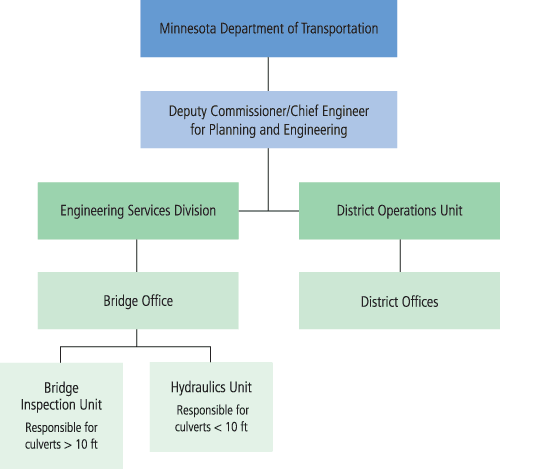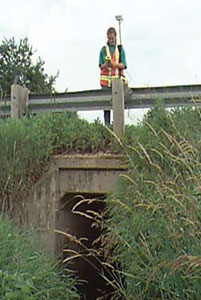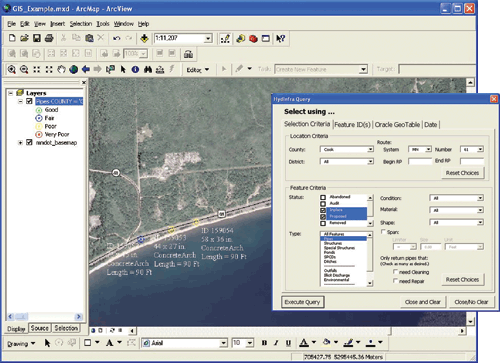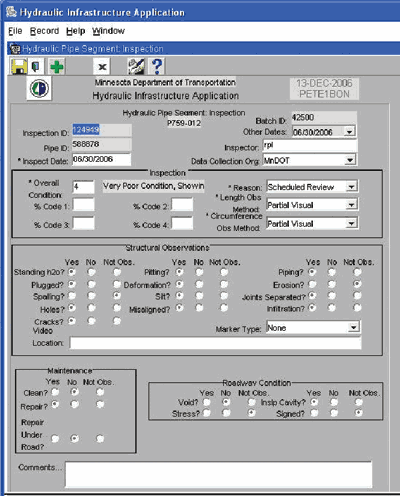Transportation Asset Management Case Studies
CMS Case Study
Minnesota
In Minnesota the responsibilities for inspection and management of State-owned culverts belong to the Minnesota DOT (MnDOT). MnDOT has eight engineering districts, each encompassing several counties; each district has a headquarters office. Most of MnDOT's day-to-day operations are managed at the district level, including highway construction projects and maintenance. MnDOT, headquartered in St. Paul, is responsible for more than 11,000 lane-miles of the State-owned trunk highway system and more than 3,800 bridges. With its additional 123,000 lane-miles of local highways and 9,800 local bridges, Minnesota has the fifth largest highway system in the Nation.
Division of Responsibilities
Within MnDOT the responsibility for culvert management and inspection is divided between the Bridge Inspection Unit and the Hydraulics Unit. Both units are part of the Bridge Office headed by the State bridge engineer. Figure 7 illustrates the MnDOT hierarchy.
The division of inventory and inspection responsibilities is based on the size of the culverts. The Bridge Inspection Unit is responsible for the inspection of structures that span more than 10 ft, while the Hydraulics Unit handles structures that span less than 10 ft. Culverts and pipes down to a 12-in. diameter are inventoried and inspected by MnDOT district personnel based on district priorities and resources.

Small culvert replacement, repair, and maintenance are done by both State forces and contractors. Most of the replacements and rehabilitations occur during corridor improvement projects. Slip lining and cured in-place liners are the most common rehabilitation methods. Replacement methods are most commonly open trench and occasional jacking, which is the horizontal placement of pipes by driving the pipe through an embankment.
Culvert replacements of all sizes on public waters require a Department of Natural Resources (DNR) permit. MnDOT has a general permit with the DNR for crossings of public waters. Fish passage is a concern for larger culverts on public waters.
Inventory and Inspection
The culverts on the State trunk highway system that span more than 10 ft are inspected on a 12- or 24-month frequency depending on the condition of the structure. Minnesota State law does not allow for inspection at intervals greater than 2 years; however, MnDOT is currently working to amend the law to allow a 4-year frequency on some structures, especially concrete box culverts. The Bridge Inspection Unit has been inventorying culverts longer than 10 ft since the early 1970s. Most of the approximately 10,500 culverts are made of steel and concrete, with some masonry, timber, and aluminum structures scattered throughout the State. These inspections are conducted by NBIS-certified inspectors.
Minnesota does not have a required inspection frequency for culverts less than 10 ft; therefore, each district can determine its own frequency. Most districts have chosen to inspect a number of these smaller structures on an as-needed basis. If the culverts are in an outfall in a Municipal Separated Storm Sewer Systems for Pollution Control area (MS-4), 20 percent of the culverts are required to be inspected each year.
Although the inspectors for these smaller structures are not required to have any NBIS training, most participate in a 1-day course focusing on condition, codes, problems, and data formatting. Inspections of smaller structures are conducted by district maintenance and hydraulic personnel, as well as contractors hired and supervised by the district. Individualized training is provided for district staff, while formal classes are held as needed for contractors. For a company to qualify for consultant work, two of its people must attend the formal training. Most culverts are inspected visually using flashlights. Video inspection is used on occasion.
Maintenance and repair of culverts, including extending culverts and placing pipes inside old box culverts, are carried out by both State forces and contractors.
Prioritization
The Bridge Inspection Unit prioritizes work on large culverts according to inspection condition ratings based on both Pontis and NBIS. The central Bridge Office is responsible for developing a needs assessment for the State-owned culverts spanning 10 ft or more in each district. The needs assessment covers short- to long-range budget needs in 7- to 9-year increments. The current needs assessment covers the following time frames:
- Short term: 7 years (2008-2014).
- Mid range: 9 years (2015-2023).
- Long term: 7 years (2024-2030).
Once the statewide needs are determined, the central Bridge Office prepares a list of recommended projects for each district. The districts must select which projects to fund and prioritize their selections.
The Hydraulics Unit has developed a culvert inspection guide that contains condition rating information and condition-state language. The ratings are based on a scale of 1 to 4, with 1 being the best condition and 4 meaning an immediate fix may be required. For the districts, pipes with a rating of 4 (emergency pipes) are top priority. Additionally, pipes with a condition rating of 3 will be fixed as time and resources permit. For corridor projects, pipes rated as 3 and 4 are reviewed and prioritized as part of the project scope.
Databases
In addition to the division in responsibilities, two different computerized management systems are used, Pontis and HYDINFRA.
Pontis
For inventory and management of the larger structures, the Bridge Inspection Unit uses Pontis. Although intended primarily for bridges, the software can be used by a DOT to manage its inventory of culverts. Pontis has the capability to predict deterioration and remaining service life and to make repair and rehabilitation recommendations.

HYDINFRA
The impetus for the development of HYDINFRA (HYDraulic INFRAstructure) came from the district hydraulics engineer's decision to create a management system for the hydraulic infrastructure on a statewide level. Development of HYDINFRA began in 1996 and was completed a year later. Prior to this, each district either did not collect data for small culverts or had its own way of inventorying and collecting data from paper records to simple databases. Fortunately, there was no catastrophic failure or event that prompted the MnDOT to manage these structures.
HYDINFRA catalogs several types of hydraulic features, as illustrated in Table 1. Although MnDOT does not differentiate culverts from storm drains, there are approximately 50,000 pipes in the inventory. MnDOT estimates that 75 percent of the State-owned pipes have been inventoried. Other than steel and concrete, the inventory has some plastic and corrugated aluminum pipes.
HYDINFRA manages both inventory and inspection data for each hydraulic feature. Examples of inventory and inspection data are shown in Table 2.
HYDINFRA data is used primarily for construction project scoping and to plan maintenance and repairs. Survey crews have used HYDINFRA data to locate culverts for more detailed mapping work. Beginning in 2006, HYDINFRA was used to find features requiring maintenance under the new water quality requirements. Inspection and maintenance activities are logged by date so that the history of problems or repairs is available for each feature.
Field inspectors collect data with global positioning system (GPS) receivers, and the data is then uploaded to an Oracle database. Geographic information tools allow users to query the database for specific information and create maps for use in various projects (see Figure 8). Users can query by condition, need for repair, or need for cleaning.
| Hydraulic Feature | Examples |
|---|---|
| Pipes | Culverts spanning between 12 in. and 10 ft |
| Storm Drains | |
| Structures | Drop inlets |
| Catch basins | |
| Manholes | |
| Special Structures | Aprons |
| Headwalls | |
| End treatments | |
| Weirs | |
| Increasers/reducers | |
| Water quality devices | Pond |
| Ditch | |
| Structural pollution control device | |
| Virtual features (added in 2006 to facilitate record keeping for National Pollutant Discharge Elimination System requirements) | Illicit discharge |
| Outfalls |
| Types of Data | Examples |
|---|---|
| Inventory | Location |
| Type | |
| Initial size | |
| Shape | |
| Material | |
| Inspection data | Condition code |
| Need for repair | |
| Need for cleaning | |
| Condition attribute flags | |
| Maintenance repairs accomplished and other changes over the life of the hydraulic feature | |
| Plan data for proposed features |
Users can access HYDINFRA reports to obtain detailed information about culverts in a specific geographic area. The Pipe Inventory and Inspection Report allows users to specify a highway and the beginning and ending milepost for the area of interest. The report lists information, line by line, about the set of pipes along that stretch of highway (see Figure 9). Data include size, shape, material, and location, plus condition ratings and detailed attribute flags that note problems in the pipes.
Oracle forms allow for data creation, editing, and access. Advanced users complete the Batch Review Form to view newly loaded data (see Figure 10). Forms also interact with the ArcGIS HYDINFRA tools, allowing data to be selected in GIS and viewed in forms and vice versa.

| Pipe ID | |||||||
|---|---|---|---|---|---|---|---|
| 588875 | 588876 | 588877 | 588878 | 588879 | 588880 | 588881 | |
| MP | 182.79 | 183.82 | 185.05 | 185.58 | 185.83 | 186.07 | 186.96 |
| Cond | 2 | 2 | 2 | 4 | 4 | 4 | 2 |
| Pipe Shape | Box | Round | Box | Round | Round | Round | Round |
| Material | Concrete | Concrete | Concrete | Concrete | Concrete | Concrete | Concrete |
| Length | 47.0 ft | 72.0 ft | 57.0 ft | 84.0 ft | 75.0 ft | 66.0 ft | 98.0 ft |
| Span x Rise | 72x48 in. | 24x24 in. | 60x60 in. | 24x24 in. | 24x24 in. | 24x24 in. | 30x30 in. |
| Cover | 2-6 ft | 2-6 ft | 2-6 ft | 6-10 ft | 6-10 ft | 6-10 ft | 10-20 ft |
| Maint. Clean | Y | Y | Y | N | N | N | Y |
| Maint. Repair | N | N | N | Y | Y | Y | N |
| Repair Under Road | N | N | N | N | N | N | N |
| Plugged | N | N | N | Y | Y | Y | N |
| Deformed | N | N | N | Y | Y | Y | N |
| Standing Water | N | Y | Y | Y | N | N | N |
| Infiltration | N | N | N | Y | Y | Y | N |
| Silt Present | Y | Y | Y | Y | Y | Y | Y |
| Piping | N | N | N | Y | Y | Y | N |
| Cracks | N | N | N | Y | Y | N | |
| Spalling / Flaking | N | N | N | N | |||
| Pitting / Rusting | N | N | N | Y | N | ||
| Misalignment | N | N | N | Y | Y | Y | N |
| Joints Separation | N | N | N | Y | Y | Y | N |
| Holes | N | N | N | Y | Y | Y | N |
| Inslope Cavity | N | N | Y | Y | Y | Y | N |
| Road Void | N | N | N | N | N | N | N |
| Road Stress | N | N | N | N | N | N | |
| Erosion | N | N | Y | Y | Y | N | |
| Inspection Date | 6/29/2006 | 6/29/2006 | 6/29/2006 | 6/30/2006 | 6/30/2006 | 6/30/2006 | 6/30/2006 |

Funding
The cost of replacing large culverts is covered by the statewide general structures budget. There is no dedicated budget for small culverts. The funds are allocated from the general roadway budget to the districts, who then prioritize projects and decide which to undertake.
For local structures, funding comes from the State gas tax, township bridge funds, and bonding. Counties and municipalities set their own budgets, select their own projects, and handle their own designs. On occasion, MnDOT offers assistance with large, complex, or unique structures.
Conclusion
In the absence of any Federal requirements, MnDOT has developed procedures and guidelines for inspection of its massive inventory of culverts and drainage structures. Although the management responsibilities are divided between two units within the Bridge Office that utilize two different management tools, MnDOT has a good handle on its small structure inventory. The use of Pontis is a practical application of an existing software package for CMS purposes. For the smaller structures, HYDINFRA can be used as a model for other States for managing their drainage systems. MnDOT has expressed a willingness to share information on their HYDINFRA with other DOTs. This evolving tool is consistently being enhanced to take advantage of the new developments in computer technology.
MnDOT sees no need for a Federal mandate to inspect culverts, especially since the State has already developed its own procedures. In fact, MnDOT maintains that a Federal mandate could be a burden to local governments. This view is consistent with the position already adopted in 2005 by the AASHTO Subcommittee on Bridges and Structures.

